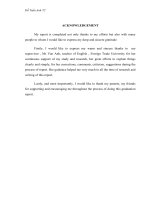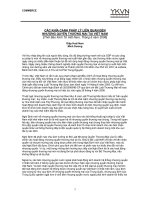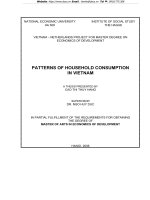Corporate Financing – Theories in Vietnam Realities
Bạn đang xem bản rút gọn của tài liệu. Xem và tải ngay bản đầy đủ của tài liệu tại đây (199.31 KB, 29 trang )
Website: Email : Tel : 0918.775.368
Hanoi National Economics University
VIETNAM – NETHERLANDS
DEVELVOPMENT ECONOMICS AND PUBLIC POLICY CENTER
ESSAY on
INTRODUCTION TO FINANCE
Topic: Corporate Financing – Theories in Vietnam Realities
Student: Le Trong Quan
Class: MDE 14
Lecturer: Dr Do Kim Son
Hanoi 2007
CH sè 11 - B1 - §H KTQD Chuyªn Photocopy - §¸nh m¸y - In LuËn v¨n, TiÓu luËn
: 6.280.688
TABLE OF CONTENTS
Part I: Introduction 3
Part II: Background – General Concepts
Equity
Debt
Other sources
5
5
7
9
Part III: Development – Theories in Vietnam realities
Economics
Legal and customary aspects
12
12
17
Part IV: Conclusions and recommendations 18
Part V: Appendix
Appendix 1: Number of acting enterprises as of annual 31 Dec.by
type of enterprise
Appendix 2: Annual average capital of enterprises by type of
enterprise
Appendix 3: Value of fixed asset and long term investment of
enterprises as of annual 31 Dec. by type of enterprise
Appendix 4: Net turnover of enterprises by type of enterprise
Appendix 5: Number of enterprises as of 31 Dec. 2005 by size of
employees and by type of enterprise
Appendix 6: Capital resources of enterprises
Appendix 7: Gross domestic product constant 1994 prices by
ownership and by kind of economic activity
Appendix 8: State budget revenue final accounts
20
21
22
23
24
25
26
27
28
Reference 29
I. INTRODUCTION
2
CH sè 11 - B1 - §H KTQD Chuyªn Photocopy - §¸nh m¸y - In LuËn v¨n, TiÓu luËn
: 6.280.688
For centuries, economists have been preoccupied with the growth of
nations. However, it seems that they can never reach a consensus on the
recommendations for governments to promote economic growth. However,
their efforts provide us a better understanding of the sources of economic
growth, in which, one of the most important factors is the growth of
enterprises. In other words, the growth of enterprises is one of most
important motivation to promote the growth of economy.
To survive and prosper, any company must produce and sell products and
services at a profit. Therefore, it needs many assets, plant, equipment,
offices, computers, technology and so on as well as other necessary current
assets. The company also has to decide which assets to buy and how to pay
for them. Therefore, the company must deal with an unavoidable problem
of how to raise money for such purchases. That is the problem of corporate
financing, an avoidable problem for any enterprises in the modern
economy.
When a company needs financing, in general, it can invite investors to put
up cash in return for a share of profits or borrow the money from investors.
In the first case, the investor receives newly issued shares of stock and
becomes a shareholder, a part-owner of the firm. In the second case, the
investor becomes a lender who must one day be repaid, usually with
interest. The decision in the source of financing determines its capital
structure, consequently greatly effect its profitability and risky level of the
company. Therefore, the financing, together with the capital budgeting are
the vital decisions made by financial managers. Any company must solve
the problems for during its growth and development.
Recognizing the importance of corporate financing, this essay focus on the
theory and reality of the problems in Vietnam in five parts as follows:
Part I: Introduction
3
CH sè 11 - B1 - §H KTQD Chuyªn Photocopy - §¸nh m¸y - In LuËn v¨n, TiÓu luËn
: 6.280.688
Part II: Background – General Concepts
Part III: Development – Theories in Vietnam realities
Part IV: Conclusions and recommendations
Part V: Appendix
4
CH sè 11 - B1 - §H KTQD Chuyªn Photocopy - §¸nh m¸y - In LuËn v¨n, TiÓu luËn
: 6.280.688
II. BACKGROUND - GENERAL CONCEPTS
When financing the capital demand, a company can rely on internal capital
(current equity plus retained earnings and depreciation) or external capital
(borrowing or issuing more stock). For the internal capital, it is the most
convenient way to for the financial manager to have enough capital for
operating his company. Obviously, the financial manager shall consider the
internal capital prior to any other capital sources. However, the internal
capital is hardly enough for new investment as well as other new capital
demanded because they have been divided into many current as fixed assets
of the company. If the company has enough internal capital for its
operation, the problem of financing may can be solved by itself.
Therefore, it is customary to classify external sources of finance as debt or
equity. When the firm borrows, it promises to repay the debt with interest.
If it doesn’t keep its promise, the debt-holders may force the firm into
bankruptcy. However, no such commitments are made to the equity-
holders. They are entitled to whatever is left over after the debt-holders
have been paid off. For this reason, equity is called a residual claim on the
firm.
Equity
If a company wishes to raise more money, it can sell more shares or stock.
However, there is a limit to the number that it can issue without getting the
approval of the current-share. Normally, this limit is approved in a General
Shareholder meeting. Nevertheless, the proposal to issue more share is not
always passed easily by the meeting. A company, pursuant to the approval
of General Shareholder meeting, can issue common stock or preferred
stock.
5
CH sè 11 - B1 - §H KTQD Chuyªn Photocopy - §¸nh m¸y - In LuËn v¨n, TiÓu luËn
: 6.280.688
In general, a joint-stock corporation is owned by its common stockholders.
Some of this common stock is held directly by individual investors, but the
other proportion may belong to financial institutions such as banks, pension
funds, and insurance companies.
Common stock, also referred to as common or ordinary shares, is, as the
name implies, the most usual and commonly held form of stock in a
corporation. Common stocks are units of ownership of a public
corporation. Owners typically are entitled to vote on the selection of
directors and other important matters as well as to receive dividends on
their holdings. In the event that a corporation is liquidated, the claims of
secured and unsecured creditors and owners of bonds and preferred stock
take precedence over the claims of those who own common stock. For the
most part, however, common stock has more potential for appreciation.
Some other companies also have preferred stock or preferred shares. They
are the shares that have preferential rights to dividends or to amounts
distributable on liquidation, or to both, ahead of common shareholders.
Preferred stock is given preference over common stock. Holders of
preferred stock receive dividends at a fixed annual rate. The earnings of a
corporation are applied to this payment before common stockholders
receive dividends. If corporate earnings are insufficient for the fixed annual
dividend, the preferred stock will absorb the total amount of earnings, and
the common stockholders will be precluded from receiving a dividend.
When corporate income exceeds the amount that is needed to pay preferred
stockholders, the remainder is generally paid to common stockholders.
Preferred stock can be cumulative or noncumulative. If it is cumulative and
if the fixed dividend remains unpaid, it becomes a debit upon the surplus
earnings of succeeding years. Accumulated dividends must be paid in full
before common stockholders can receive dividends. When preferred stock
6
CH sè 11 - B1 - §H KTQD Chuyªn Photocopy - §¸nh m¸y - In LuËn v¨n, TiÓu luËn
: 6.280.688
is noncumulative, its preference is extinguished by the failure of the
corporation to have sufficient earnings to pay the fixed dividend in a given
year.
Some preferred shares have special voting rights to approve certain
extraordinary events (such as the issuance of new shares or the approval of
the acquisition of the company) or to elect directors, but most preferred
shares provide no voting rights associated with them. Some preferred
shares only gain voting rights when the preferred dividends are in arrears
for a substantial time. Besides, there are some other kinds of preferred
stock such as convertible preferred stock, exchangeable preferred stock,
participating preferred stock and perpetual preferred stock.
A company also can buy back the stocks issued by itself to reduce the
number of outstanding stocks on the open market. These stocks are call
treasury stocks, treasury shares or reacquired stocks. In case of necessary,
the company can sell its treasury stocks at market value to finance its
operation. However, the selling or buying of treasury stocks still depend on
the limit set by company charter as well as other regulation set by the
General shareholder meeting, Board of management and other relevant
authorities.
Debt
In order to raise money for operation, a company can also borrow capital
from different sources in different forms. When companies borrow money,
they promise to make regular interest payments and to repay the principal.
However, this liability is limited. Stockholders have the right to default on
the debt if they are willing to hand over the corporation’s assets to the
lenders. Clearly, they will choose to do this only if the value of the assets is
less than the amount of the debt.
7
CH sè 11 - B1 - §H KTQD Chuyªn Photocopy - §¸nh m¸y - In LuËn v¨n, TiÓu luËn
: 6.280.688
When companies borrow money, they promise to make regular interest
payments and to repay the principal. However, this liability is limited.
Stockholders have the right to default on the debt if they are willing to hand
over the corporation’s assets to the lenders. Clearly, they will choose to do
this only if the value of the assets is less than the amount of the debt.
In general the mixture of loans that each company issues reflects the
financial manager’s response to a number of questions:
1. Should the company borrow short-term or long-term? It depends on the
characteristics of the capital demand and current financial situation of the
company. Normally, short-term loan is to finance current assets and long-
term loan is for fixed assets. However, depend on the financial balance of
the company, the financial manager can decide to finance long-term
investment by sort-term loan or finance current assets by long-term loans.
Obviously that this decision must be accepted by the bankers.
2. Should the debt be fixed or floating rate? The interest payment, or
coupon, on long-term bonds is commonly fixed at the time of issue.
However, most bank loans and some bonds offer a variable, or floating,
rate. For example, the interest rate in each period may be set at 1 percent
above LIBOR (London Interbank Offered Rate), which is the interest rate
at which major international banks lend dollars to each other. When
LIBOR changes, the interest rate on your loan also changes.
3. Should you borrow in domestic currency or some others? The financial
manager shall decide the problem base on the interest rate, exchange rate,
source of revenue and forecast of above-mentioned factor.
4. What promises should you make to the lender? Lenders want to make
sure that their debt is as safe as possible. Therefore, they may demand that
their debt is senior to other debt. If default occurs, senior debt is first in line
to be repaid. The junior, or subordinated, debtholders are paid only after all
8
CH sè 11 - B1 - §H KTQD Chuyªn Photocopy - §¸nh m¸y - In LuËn v¨n, TiÓu luËn
: 6.280.688
senior debtholders are satisfied (though all debtholders rank ahead of the
preferred and common stockholders). The firm may also set aside some of
its assets specifically for the protection of particular creditors. Such debt is
said to be secured and the assets that are set aside are know as collateral.
Thus a retailer might offer inventory or accounts receivable as collateral for
a bank loan. If the retailer defaults on the loan, the bank can seize the
collateral and use it to help pay off the debt.
5.Should you issue straight or convertible bonds? Companies often issue
securities that give the owner an option to convert them into other
securities. These options may have a substantial effect on value. The most
dramatic example is provided by a warrant, which is nothing but an option.
The owner of a warrant can purchase a set number of the company’s shares
at a set price before a set date. Warrants and bonds are often sold together
as a package. A convertible bond gives its owner the option to exchange
the bond for a predetermined number of shares. The convertible bondholder
hopes that the issuing company’s share price will zoom up so that the bond
can be converted at a big profit. But if the shares zoom down, there is no
obligation to convert; the bondholder remains a bondholder.
Other sources
Besides above mentioned sources of financing, a company also can look
for other capital sources based on specific cases.
Leases come in many forms, but in all cases the lessee (user) promises to
make a series of payments to the lessor (owner). The lease contract
specifies the monthly or semiannual payments, with the first payment
usually due as soon as the contract is signed. The payments are usually
level, but their time pattern can be tailored to the user’s needs. For
example, suppose that a manufacturer leases a machine to produce a
complex new product. There will be a year’s “shakedown” period before
9
CH sè 11 - B1 - §H KTQD Chuyªn Photocopy - §¸nh m¸y - In LuËn v¨n, TiÓu luËn
: 6.280.688
volume production starts. In this case, it might be possible to arrange for
lower payments during the first year of the lease. When a lease is
terminated, the leased equipment reverts to the lessor. However, the lease
agreement often gives the user the option to purchase the equipment or take
out a new lease.
Some leases are short-term or cancelable during the contract period at the
option of the lessee. These are generally known as operating leases. Others
extend over most of the estimated economic life of the asset and cannot be
canceled or can be canceled only if the lessor is reimbursed for any losses.
These are called capital, financial, or full-payout leases.
Financial leases are a source of financing. Signing a financial lease contract
is like borrowing money. There is an immediate cash inflow because the
lessee is relieved of having to pay for the asset. But the lessee also assumes
a binding obligation to make the payments specified in the lease contract.
The user could have borrowed the full purchase price of the asset by
accepting a binding obligation to make interest and principal payments to
the lender. Thus the cash-flow consequences of leasing and borrowing are
similar. In either case, the firm raises cash now and pays it back later. A
large part of this chapter will be devoted to comparing leasing and
borrowing as financing alternatives.
Most financial leases are arranged for brand new assets. The lessee
identifies the equipment, arranges for the leasing company to buy it from
the manufacturer, and signs a contract with the leasing company. This is
called a direct lease. In other cases, the firm sells an asset it already owns
and leases it back from the buyer. These sale and lease-back arrangements
are common in real estate.
10
CH sè 11 - B1 - §H KTQD Chuyªn Photocopy - §¸nh m¸y - In LuËn v¨n, TiÓu luËn
: 6.280.688
In short-term, a company can use delayed payment for account payables.
Delayed payment is sometimes called stretching your payables. Stretching
is one source of short-term financing, but for some firms it is an expensive
source, because by stretching they may lose discounts given to firms that
pay promptly.
A company also can ask their partner for deposit or payment in advance.
These payments are important source of financing, especially for small
companies. However, except for the case of monopolistic companies, these
methods usually associated with the conditions in prices and other term.
Furthermore, the sustainability of the company corresponding to the source
of financing is a very important factor greatly effecting the decision in
choosing financial source.
11









